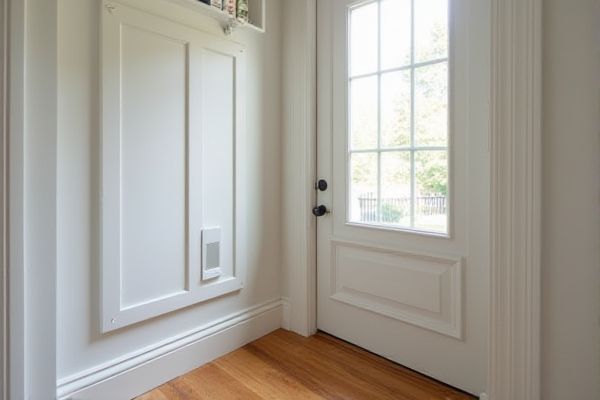
Choosing between a mudroom wall vent and a floor vent impacts airflow efficiency and temperature control in your space. Discover which vent option best suits Your mudroom's layout and needs by reading the rest of the article.
Table of Comparison
| Feature | Mudroom Wall Vent | Mudroom Floor Vent |
|---|---|---|
| Installation Location | Mounted on mudroom wall | Installed on mudroom floor |
| Airflow Efficiency | Direct horizontal airflow, ideal for wall height circulation | Vertical airflow, effective for heating/cooling floor level |
| Space Usage | Saves floor space, less obstruction | Requires clear floor area, potential obstruction risk |
| Cleaning & Maintenance | Easier to clean, less dirt accumulation | Prone to debris buildup, requires frequent cleaning |
| Durability | Less exposure to foot traffic, longer lifespan | Susceptible to damage from foot or equipment contact |
| Heating & Cooling Impact | Good for consistent air distribution at mid-level | Efficient for floor heating systems and cold air return |
| Cost | Typically moderate installation cost | May involve higher installation effort and cost |
Introduction to Mudroom Ventilation
Mudroom ventilation plays a crucial role in maintaining air quality and controlling humidity in transitional spaces between outdoors and indoors. Wall vents in mudrooms promote efficient airflow at a mid-level height, preventing moisture buildup and reducing mold risks, while floor vents are positioned near the ground to facilitate warmth and air circulation during colder months. Choosing between wall vent vs floor vent depends on the mudroom's layout, climate considerations, and moisture management needs.
Importance of Vent Placement in Mudrooms
Proper vent placement in a mudroom is crucial to maintain air circulation and prevent moisture buildup. Wall vents effectively promote airflow at a higher level, reducing dampness from wet shoes and outerwear stored below. Your mudroom benefits from floor vents by warming the lower space, but wall vents better control humidity, enhancing comfort and preventing mold growth.
Overview of Wall Vents for Mudrooms
Wall vents for mudrooms provide efficient airflow at an elevated level, helping to reduce moisture and prevent mold buildup by promoting better air circulation in confined spaces. Unlike floor vents, wall vents minimize the risk of dirt and debris clogging the vent, making maintenance easier and more effective in mudroom environments. Your mudroom benefits from wall vents by maintaining a cleaner, drier atmosphere that helps protect shoes, coats, and other stored items from damp conditions.
Overview of Floor Vents for Mudrooms
Floor vents in mudrooms provide efficient airflow and temperature control at ground level, ideal for warming the space during cold months. These vents help prevent moisture buildup by promoting air circulation where water and dirt commonly accumulate. Positioned strategically, floor vents enhance comfort and maintain a dry, odor-free environment in mudrooms.
Thermal Efficiency: Wall vs. Floor Vents
Wall vents in a mudroom typically provide better thermal efficiency by allowing warm air to distribute evenly at eye level, reducing cold drafts near the floor. Floor vents can sometimes trap cold air close to the ground, leading to uneven heating and increased energy use. Choosing the right vent placement helps maintain your mudroom's temperature balance, optimizing comfort and energy savings.
Moisture Control and Air Circulation
Mudroom wall vents provide enhanced moisture control by promoting better air circulation at eye level, helping to reduce condensation on walls and prevent mold growth. Floor vents may trap moisture near the ground, increasing the risk of dampness and mildew in your mudroom. Installing a wall vent optimizes air flow and keeps your mudroom dry and comfortable.
Installation and Maintenance Differences
Mudroom wall vents offer easier installation options since they can be mounted directly onto existing walls without extensive floor modifications, reducing labor and material costs. Maintenance for wall vents is generally simpler as they are less prone to dirt and debris accumulation compared to floor vents, which require frequent cleaning due to foot traffic and debris buildup. Wall vents also allow for better airflow control and reduced risk of damage from mud and water, common issues with floor vent placements in mudrooms.
Aesthetic and Space Considerations
Mudroom wall vents provide a sleek, unobtrusive appearance that enhances overall aesthetics by blending seamlessly with the wall surface, making them ideal for smaller spaces or narrow entryways. Floor vents, often more visible, can consume valuable floor space and require careful placement to avoid obstructing walking paths or storage areas in the mudroom. Choosing wall vents maximizes usable floor space and maintains a clean, organized look, while floor vents might offer more efficient airflow but at the expense of spatial convenience.
Cost Comparison of Wall and Floor Vents
Wall vents generally cost between $30 and $80 per unit, including installation, making them moderately priced for efficient airflow in mudrooms. Floor vents typically range from $50 to $120 installed, reflecting higher labor costs due to floor modifications and potential subfloor adjustments. Choosing between wall and floor vents depends on budget constraints and specific mudroom design requirements, with wall vents often proving more cost-effective in standard installations.
Best Vent Option for Your Mudroom
Choosing the best vent option for your mudroom depends on airflow efficiency and space utilization; wall vents often provide better air circulation by allowing warm or cool air to enter at eye level, promoting faster temperature regulation. Floor vents can be obstructed by shoes, mats, or storage items common in mudrooms, reducing their effectiveness and potentially compromising comfort. Your mudroom benefits most from a wall vent to maintain clean air flow and prevent blockages in this high-traffic area.
 homyna.com
homyna.com